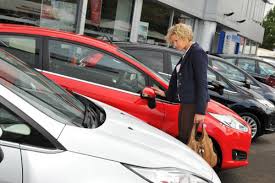What should you not do at a car dealership?
A lot of people will offer hints on what to do in the dealership when it comes time to buy a car. And tips on test driving, negotiation, and financing are valuable. But the path to a car purchase is so strewn with boulders that if you don’t watch your step, you can stub a toe or even break a leg, metaphorically speaking. Car buying can be such a complicated process that knowing what not to do in the dealership might be even more important than knowing what to do.
If you do one or more of these seven things we advise against, it will make getting a good deal harder. Don’t make things more difficult for yourself. You want to land the right vehicle for the best possible price, so here’s what you should not do when you visit the dealership:
Don’t Enter the Dealership without a Plan
You can stroll into a restaurant without knowing what you want to eat and get a good meal. You can wander into a big-box store just to kill some time and walk out with a decent microwave oven or button-down shirt. But if you mosey into a car dealership lacking a plan, there is a good chance you’ll come out with a crater-size hole in your bank account. Not only that, your misspent Saturday morning could haunt you for years to come. A car purchase should not be an impulse buy. Know—don’t guess, know—what your current car is worth, what the car you plan to buy is selling for, how much money you can put down, and how much money you can spend on a monthly car payment. If you know all this going in, you’ll be way ahead of most car buyers.
Don’t Let the Salesperson Steer You to a Vehicle You Don’t Want
Typically, a dealership is always trying to sell the vehicles it has in stock, Fuller told us. And that is not always in the best interest of the customer. “If the salesperson really knows the inventory, then he or she is trying to match up the customer with something that can be sold today,” Fuller said. If you are not specific and firm about what you want, the dealership will attempt to put you into a vehicle that it’s trying to move, even if it isn’t what’s best for you. Don’t let yourself be sold a car.
Don’t Discuss Your Trade-In Too Early
It’s almost always possible—with time and effort—to sell an old car privately for more than the dealer offers in trade. Many buyers nevertheless find the convenience of driving their old car in and their new one away compelling. If that’s your aim, research the value of your trade-in beforehand but decline offers or pressure to discuss it until after you’ve settled the price on the new car. If it turns out that you’re “upside down” on the old car—that is, you owe more money on it than you’re getting in trade—you probably don’t belong in a new-car dealership yet. At the least, the car should be sold privately to pay off the debt. Yes, the dealer will offer to roll your old debt into a new loan. But that’s not a good idea.

Don’t: Tell Them Your Limit On Monthly Payments
One thing you shouldn’t go in saying is something along these lines: “I’m looking for monthly payments of no more than $350.” Even though monthly payments are probably an important factor for a buyer, don’t discuss this with a dealer during negotiations.
The first step is always to settle on a price before you enter other negotiations. Deal with one thing at a time. Price first, monthly payments second, and we’ll explain why in a second.
Just know that if a dealer asks you what you’re comfortable paying every month, tell them that you aren’t comfortable discussing that until you both have determined the overall price of the car. Always deal with total price before you talk financing, because things can get confusing otherwise.
Don’t: Ask How Much You’ll Get For Your Trade-In
If you have a trade-in to discuss, be sure not to mention this until you’ve negotiated the deal on the price of the car you’re set on buying. It might be tough, because you’re excited to be buying a new car and to be get rid of your old one, but trading in a car and buying a car are two separate transactions, and should be treated as such.
If you throw your trade into the negotiation, a dealer can leverage that to confuse you on how much you’re actually paying for the car you’re buying. Also, if the dealer knows he owes you a set price on a trade-in, it might be tough to get him to help you out on lowering the MSRP of the car you’re buying. If the dealer asks if you’re trading in, just say you’re considering it but haven’t decided.

Don’t Waste Your Money on These Costly Add-Ons
After negotiating a price for a new car, you might think that the amount you’ll have to pay before driving off the lot is set in stone. Then you enter the financing office, which can be the most dangerous place in the dealership for your wallet if you’re not prepared.
When you buy or lease a car, most finance managers or sales consultants will try to sell you several add-ons. Knowing which dealer add-ons are worth it and which are not can save you thousands of dollars. Before you buy, it’s crucial you research the products, their prices, and their availability outside of the dealership.
Unfortunately, some of the add-ons you’ll be offered are of questionable value, have massive markups, or can be found from other sources for a fraction of the price. Dealerships won’t typically offer rustproofing or undercoating these days as they did so often in the past. Still, they have a plethora of pricey new add-ons, with aggressive sales pitches to match.
There are benefits to buying some things at the dealership. Some add-ons can be included in your financing, so you don’t have to pay the full price upfront. Some are covered by your car warranty and can be serviced at the dealership if they fail. Quite often, however, the benefits are outweighed by high markups and the interest you’ll have to pay if you include them in your car’s financing. Because add-ons don’t typically add value to a vehicle, they can leave you with an auto loan balance that’s far higher than the car’s resale value.
On the following pages, we’ll explore some of the add-ons you’ll likely be offered at the car dealership. Many are available with cheaper options elsewhere.

Extended Warranties
Start talking about extended warranties, and you’ll find that people don’t agree whether they’re great or a waste of money. Extended warranties, vehicle protection plans, and vehicle service contracts promise to pay for things that fail after the manufacturer’s warranty ends.
If you pay full price at a car dealer for an extended warranty at the time you buy your car, you’ll likely overpay – sometimes by thousands of dollars. Extended warranties, especially those backed by the car’s manufacturer, may save you some money if you have a catastrophic vehicle failure after your car’s original warranty expires.
When it comes to third-party extended warranties and service contracts, the only thing larger than the markup is the amount of fine print in the contract.
There’s simply no way to thoughtfully research an extended warranty offer while you’re in the dealership’s finance office, and it’s a huge mistake to try. If you do want to consider the warranty, insist on seeing the actual contract, as the glossy brochures don’t ever include all the details and exceptions. It’s a good idea to contact the Better Business Bureau or other consumer advocacy agency where the warranty company is based. You want to see if other consumers have filed complaints and how long the company has been in business.
With any extended auto warranty, a key consideration is where you can get extended warranty service. If the only repair shop you can use is the dealer you purchased the car from, the service contract becomes worthless if you move. Be sure to look at repair deductibles, and the process for getting a claim approved.
Despite any pressure they may apply, you don’t have to buy an extended warranty at the same time you buy the car. You also don’t have to purchase an extended car warranty from the dealership, unless it’s the brand’s own program. Instead, you should talk to your lender, insurance agent, and do some online research to find and price other options.
The best car buying tips:
Don’t just think about the monthly payment.
The most important car buying tip I can offer in this blog post is that you should not just care about the monthly payment. You should only purchase what you can actually afford. Just because the monthly car payment looks affordable, it doesn’t mean that it actually is.
There are car payment terms that are as long as 96 months, which is just crazy to me. A car salesperson may stretch out the car payment so that it looks to be more affordable for you, but you should be aware of the whole cost, which includes things like interest and taxes. Please, please, please, look at the whole cost and see if that’s actually an affordable amount for you to be paying.
Shop around for your own financing.
If you have to finance your car purchase, make sure you shop around before you agree to the dealer’s interest rate. Sometimes the dealer has the lowest rate, but sometimes they don’t. You may be able to save yourself hundreds of dollars a year by simply shopping around. Plus, it’s extremely easy to shop around for the best interest rates – start with local credit unions and banks!
Go to a few car dealerships.
You can shop around car dealerships both online and offline.
I recommend shopping online before you go to a dealership, this way you can be prepared by learning as much as possible in advance. You also won’t be wasting your time at car dealerships that can’t get down to the price you want.
Don’t add small and unnecessary extras at the end of your purchase.
When you are about to purchase a car, you will be encouraged to buy many small options that you may not need. This may include extras such as:
- Tire replacement
- Paint protection
- Extended warranties
While you may believe that you need some of the above options, you should make sure that you’re not just thinking about the monthly cost. The financing manager will offer you these extras in a way that makes it seem affordable. But, these extras only appear inexpensive because they are padded into your monthly cost, so don’t be fooled by how “affordable” they seem.